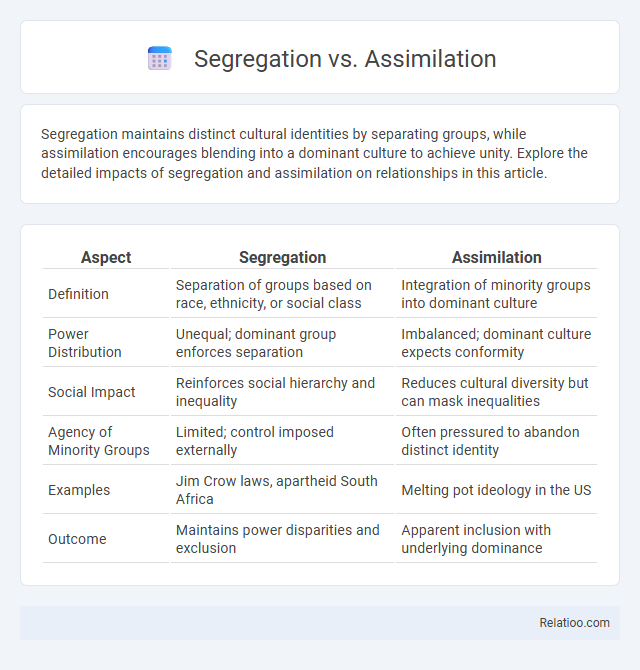Segregation maintains distinct cultural identities by separating groups, while assimilation encourages blending into a dominant culture to achieve unity. Explore the detailed impacts of segregation and assimilation on relationships in this article.
Table of Comparison
| Aspect | Segregation | Assimilation |
|---|---|---|
| Definition | Separation of groups based on race, ethnicity, or social class | Integration of minority groups into dominant culture |
| Power Distribution | Unequal; dominant group enforces separation | Imbalanced; dominant culture expects conformity |
| Social Impact | Reinforces social hierarchy and inequality | Reduces cultural diversity but can mask inequalities |
| Agency of Minority Groups | Limited; control imposed externally | Often pressured to abandon distinct identity |
| Examples | Jim Crow laws, apartheid South Africa | Melting pot ideology in the US |
| Outcome | Maintains power disparities and exclusion | Apparent inclusion with underlying dominance |
Understanding Segregation and Assimilation: Key Definitions
Segregation refers to the enforced separation of groups based on race, ethnicity, or other characteristics, often leading to unequal access to resources and opportunities. Assimilation involves the process through which minority groups adopt the cultural norms of a dominant group, sometimes resulting in the loss of original cultural identities. Understanding these concepts helps you recognize how social structures impact identity, inclusion, and community dynamics.
Historical Context: Evolution of Segregation and Assimilation
Segregation and assimilation have evolved through complex historical processes shaped by social, political, and legal forces. Segregation, institutionalized through laws like Jim Crow in the United States, enforced the separation of racial and ethnic groups, while assimilation emerged as a response encouraging minority groups to adopt the dominant culture's norms. Your understanding of these dynamics highlights how assimilation often aimed to erase cultural identities, whereas segregation reinforced systemic inequality and social hierarchies.
Social Dynamics: How Segregation Shapes Communities
Segregation creates distinct social boundaries that limit interaction between groups, fostering environments where disparities in resources, education, and economic opportunities are pronounced. Communities affected by segregation often experience reduced social cohesion, increased prejudice, and hindered social mobility, reinforcing cycles of inequality. The spatial division imposed by segregation shapes community identity and access, influencing social networks and collective efficacy.
The Process of Assimilation: Integration into Dominant Cultures
Assimilation is the process by which individuals or groups adopt the cultural norms, values, and behaviors of the dominant society, often leading to the loss of their original cultural identity. This integration involves language acquisition, participation in social institutions, and acceptance of social roles defined by the dominant culture. Successful assimilation requires navigating systemic barriers while balancing the preservation of ethnic heritage and full inclusion in mainstream society.
Cultural Identity: Preservation vs. Conformity
Segregation emphasizes preserving cultural identity by maintaining distinct social and cultural boundaries, allowing Your community to retain unique traditions and languages without external influence. Assimilation prioritizes conformity, encouraging individuals to adopt the dominant culture's norms and values, often resulting in diminished visibility of original cultural traits. Integration balances these approaches by promoting participation in broader society while still preserving critical elements of cultural identity, fostering both social inclusion and cultural diversity.
Educational Impacts: Segregation vs. Inclusive Learning
Segregation in education often leads to unequal resource allocation, limited social interaction, and reduced academic achievement for marginalized students, perpetuating systemic inequalities. Inclusive learning environments promote diversity, foster mutual respect, and enhance critical thinking skills by encouraging collaboration among students from varied backgrounds. Research indicates that inclusive education improves student engagement, reduces prejudice, and supports better long-term educational and social outcomes compared to segregated settings.
Political and Legal Perspectives on Integration
Political and legal perspectives on integration emphasize the contrast between segregation, assimilation, and multiculturalism in shaping social cohesion and minority rights. Segregation enforces distinct boundaries through policies that limit minority access to political participation and legal protections, whereas assimilation pressures minorities to abandon cultural identities to gain full citizenship rights. Multiculturalism advocates for legal frameworks that recognize and protect diverse cultural identities while promoting equal political representation and anti-discrimination laws, ensuring Your integration respects both individual rights and societal unity.
Case Studies: Real-World Examples of Segregation and Assimilation
The landmark Brown v. Board of Education case exemplified the legal battle against racial segregation in U.S. public schools, leading to widespread desegregation efforts. In contrast, the assimilation policies applied to Native American boarding schools aimed to eradicate indigenous cultures by enforcing English language use and Christian practices, reflecting a forced cultural assimilation approach. South Africa's apartheid system demonstrated institutionalized racial segregation, while the multicultural policies of Canada represent a successful model of cultural assimilation and integration.
Psychological Effects on Individuals and Groups
Segregation fosters social isolation and reinforces in-group/out-group biases, leading to increased anxiety, low self-esteem, and diminished group cohesion. Assimilation pressures individuals to conform culturally, often causing identity confusion, loss of heritage, and psychological distress due to perceived rejection by both minority and majority groups. Integration, as a balanced approach, promotes psychological well-being by supporting cultural identity while encouraging social interaction, enhancing self-esteem, and reducing intergroup prejudice.
Moving Forward: Promoting Equity and Social Cohesion
Promoting equity and social cohesion requires addressing the impacts of segregation, assimilation, and integration by fostering inclusive policies that respect cultural diversity while encouraging shared community values. Your role involves supporting initiatives that reduce systemic barriers and create equitable opportunities for all groups to thrive together. Emphasizing collaboration and mutual understanding helps build a cohesive society where differences strengthen rather than divide.

Infographic: Segregation vs Assimilation
 relatioo.com
relatioo.com